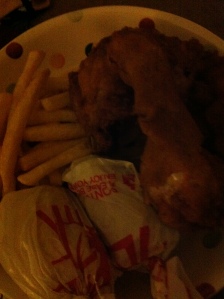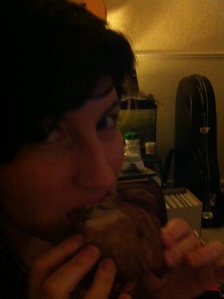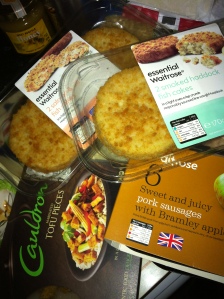I went to visit an abattoir. Then I went and got a new tyre for my car and then volunteered at the museum. Then I went home and had spleen for tea and watched Clash of the Titans (original) and then went to bed. The important bit was the word ABATTOIR.
Basically, since I’m a massive celebrity now (*pinches salt and hopes that one man coming to work to say he’d heard me on the radio counts*), the lovely Kate at John Penny invited me to come and look at their processes. So lovely are John Penny Meats that they invited me long before my celebrity stardom, when I was just a lonely carnivore searching West Yorkshire for some udder.
So first of all I should say THANK YOU to them for being really kind and showing me all around the site. I should also say – if you have a feeling of trepidation about reading further – don’t because my experience was overwhelming positive.
John Penny is a family-run farm, abattoir and meat wholesaler. Not only do they raise their own animals, but all the animals they do kill spend time on their pasture around in and around the Aire valley. They are dedicated to producing ethically-sourced and expertly processed meat. They are a very open business (hence the invitation) and take pride in the fact that there is a clear transparency in what they do. In my opinion they appear to be setting an amazing benchmark – not just for other meat producers to follow – but we can all learn from their standards of quality and sourcing. They run a campaign to get people to return to shopping at a local butcher. Do, please, devote some time to their website.
I said to my boyfriend the night before “I hope it doesn’t make me vegan” – not because I am against veganism (I am definitely pro) – but because I hoped it would be a positive experience. I pulled into the car park at 7.20 am and crossed my fingers.
The tour of the abattoir took place in reverse. I was shown around by a lovely man called Clive, who was in charge of the abattoir. This means that you’ll see what I saw, which was from the packaged product through to the babes in their mangers.
The first task I had to do was to suit up – cover my hair, my clothes, get some white wellies on and remove all my jewellery. I also had to pass my own ‘health inspection’ to make sure I hadn’t suffered from any recent illnesses. I passed. All would be well.
The first area Clive took me to was the chilled storage area where the packaged meat is kept until it shipped out.

By the time I got there, most had been loaded to lorries and taken away. Open your mind’s eye and imagine just how much meat they could be in there. Lots. More than is in the offal drawer in my freezer. In here, Clive explained how the labelling system they have works: each animal has its personal passport number which is fed into the system when they go into the abattoir. Checked and double-checked, this system not only keeps track of individual animal as they are slaughtered and butchered, but reams of other information as well. This code is transferred to the meat packs, so that a butcher anywhere in the country can then access the information themselves. As we’ll see there are lots of stages, so keeping provenance attached to the animal needs a lot of care.
The next room we saw was where carcasses were being turned into the large joints that get sent to butchers (which then become our steaks and chops). Here the men wore chain-mail and had very sharp knives. The pace of work appeared incredibly fast to me.
The next few rooms were where the half carcasses wait, hanging, until the butchers are ready for them. The scale is monumental. Beef cattle are massive.

What was interesting, was that to continue to ensure that the provenance of each animal is kept, each of these sides has seven labels put on it with the same information, so each section retains the information through to the end processes. Doesn’t the meat look beautiful too?
Another interesting thing is that you can still tell whether they are male (steer) or female (heifer) long after all the reproductive organs are removed. If you look at the one above on the left, there is a bulge of fat next to the hind leg (they are hung up by their hind legs). This fat means it is a heifer. (On a personal note, having been called a fat heifer at primary school, the still-slightly-sensitive-nine-year-old prefers the much less professional term of lady-cow.)

In this picture you can use a bone in the middle of the carcass that looks a bit like an elongated and bent butternut squash. This is the *snigger* willy bone. That’s how you tell the difference. The caracass above is a steer. I’ve deliberately not used the word ‘boner’ at any point. Deliberately.
From these cathedrals of meat we headed along to the production line, where the animals are slaughtered, skinned, disembowelled and health-checked. There’s a lot of action going on. It appeared to me that each person had their role in the process and it was a well-oiled machine. I tried to stay out of the way as much as I could.

This is just part of the line of slaughtermen that do all the things to the animals. The gentleman in the middle is Glen. He was very deft at getting the intestines out of these lambs. He also gave me a lovely smile.
I shouldn’t have been surprised at how well-organised and defined all the roles were, but I was a little. I think that’s because a lot of the information that is popularly received puts the word ‘slaughter’ in a very negative way and depicts abattoirs as chaotic places. To be honest, all the premises were far, far cleaner than my house, people were constantly sweeping, tidying and sharpening knives.
Two vets are at work at the abattoir all the time as well. One inspects the chest organs of every animal, whilst the other ensure the animals are looked after to the highest standards.
Here, the vet is inspecting the organs for disease. John Penny require such high standards in the stock that they buy, that finding any sign of disease in one of their animals is extremely rare. Apparently, the farmers that do sell stock animals to them work very hard to make sure the animals are to a standard that John Penny will accept.

When I tried to take the picture, the vet stepped backwards. Photography has never been my strong point. However I do like the disembodied blue gloves feeling some lights up in a bit of carcass steam. Atmospheric.
Clive was at pains to stress to me that certainly at John Penny, nothing is wasted from the carcasses. Someone buys the hides to make shoes with. The bovine penises are shipped to the Far East. A lot of offal goes to the other side of the Pennines (apparently Lancashire is an offal hotspot). Everything, from every animal goes somewhere.
And then we get to the killing.
I’m not squeamish, so I hoped I wouldn’t be squeamish about this. I wasn’t. The anatomist in me found it fascinating. The carnivore in me wasn’t bothered (I’ve known all my life where meat comes from). The animal-lover (who once owned 16 animals at one time in a bizarre post-heartbreak petting zoo) thought that the respect shown to each animal was really very beautiful.
First I saw some sheep die. A few at a time are led into a pen and then they are stunned individually, hung up by a back leg and then their throat is cut. It’s a very calm process. So concerned was Clive that I might upset and stress the sheep that I had to stand behind a plastic curtain, peering through. (I’m not that alarming surely?) In spite of the fact, other sheep were being stunned in front of them, the others really didn’t seem concerned. (I imagine they were too busy puzzling over the peeping Tom in the corner.) The kill happens so fast that it is seconds between the stun and the throat-cutting and death. I can think of far worse ways to go. (I am not advocating cannibalism.)
The scale of the deaths of the cattle is greater. Cattle are huge. Again, all I saw was respect, a swift death for each animal and an extremely efficient butchering process. The slaughtermen are raised up on platforms to work, because cows are so big. It was amazing to see. Then Clive and I journeyed round to see the living animals.
Stress makes animals unhappy. Pre-death stress makes meat taste sour due to hormone releases. For both of these reasons, great pains have been taken to ensure that the animals are kept as calm as possible before they die. I saw the guys checking ear-tags as gently as they could to minimise upset. It is also the reason that stock animals have months if not years in the Penny fields before being slaughtered, so that they can recover from quite long journeys from the farms they were born on. I also saw the cattle truck John Penny has. It is plush. I wouldn’t mind a ride in it.

I choose to eat meat. I choose not to shy away from where it comes from. To me, it is a case of being honest with myself and thinking about the factors behind what I eat that I find it important. I think sustainability is important and animal welfare. The journey of this year has been about trying to renege my ‘offal debt’ and make up for a lifetime of not eating animals in a holistic manner. If you asked yourself the honest question of ‘do you trust where your meat comes from?’ can you say yes?
I’m not perfect, so my answer would be No. Sometimes I eat sausages from the ‘Spoon at the end of the road. They probably contain more mechanically recovered meat than anything else. I am trying though. What is great to see is that at the other end of the food chain, much greater efforts are being made to look after animals to a high standard and deliver a quality product.
I said to Kate (slightly dazed at the end of a long morning): “That was really beautiful”. It is. From the rhythms of the slaughtermen amongst the machinery to the cows chewing cud in the fields behind, there is a lot to be said for visiting where food you eat is produced and seeing that other people put as much care and respect into it, as you would like to imagine.

Tags: abattoir, day trip, heifer, john penny, john penny meat, offal, steer
























